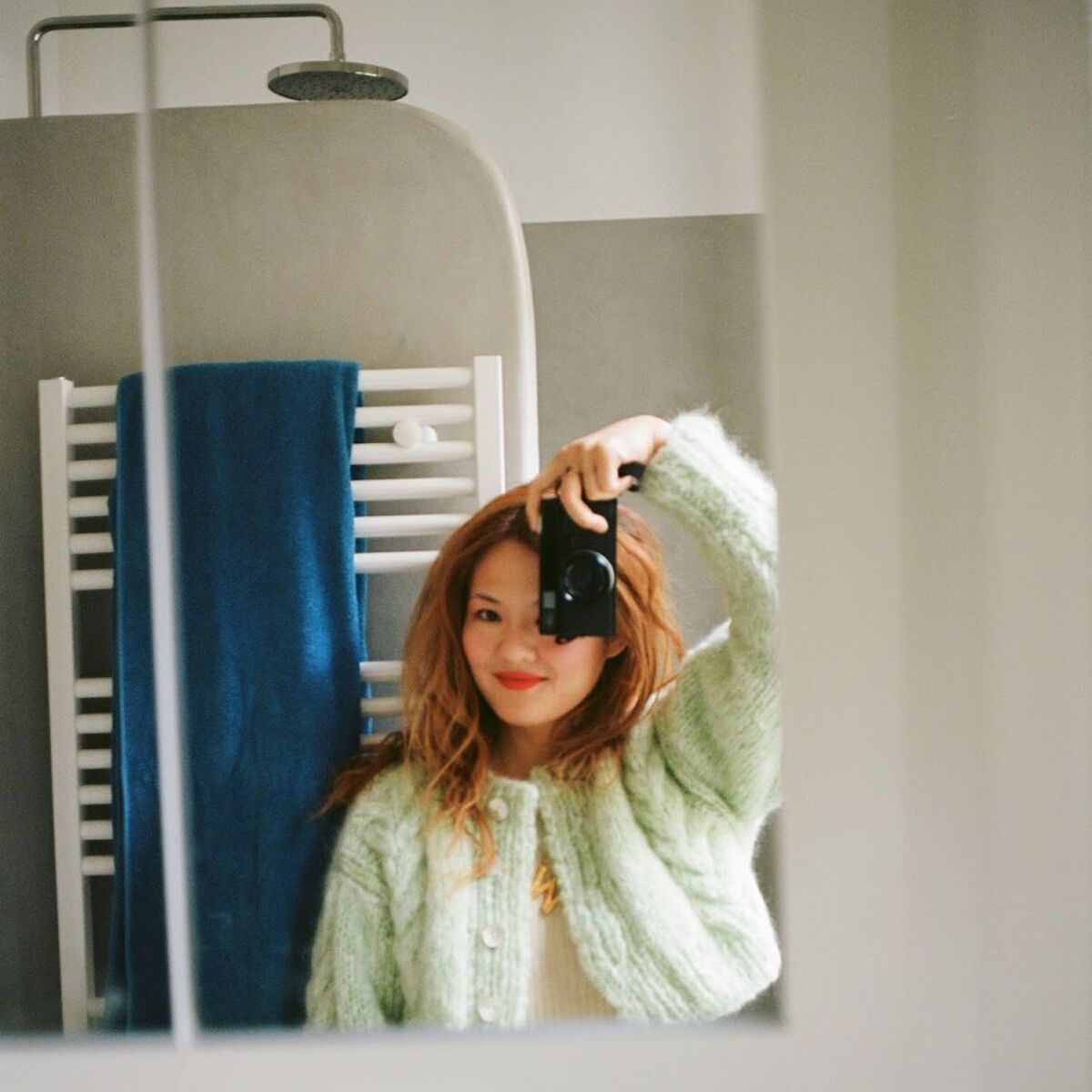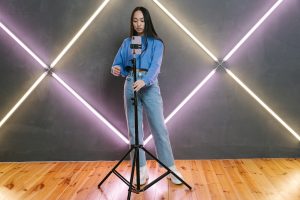Lighting
When it comes to taking a good mirror pic, lighting is everything. The right lighting can make or break your photo, so it’s important to choose the right setup. Here are some tips on how to achieve the perfect lighting for your mirror selfie:
- Natural Light: The best lighting for mirror selfies is natural light. Find a location near a large window or an outdoor spot with ample natural light. Natural light creates a soft, even illumination that enhances your features and makes your photo look more professional.
- Avoid Harsh Lighting: Harsh lighting, such as direct sunlight or bright artificial lights, can create unflattering shadows and wash out your features. If you’re shooting indoors, try to diffuse the light by using curtains or sheer fabrics to soften the intensity of the light source.
- Experiment with Angles: When it comes to mirror selfies, the angle of the light source can make a big difference. Try adjusting the angle of the light to find the most flattering illumination. Side lighting can help create dimension and highlight your facial features, while overhead lighting can add a soft glow to your skin.
- Use Reflectors: If you find your lighting to be too harsh or uneven, consider using a reflector. A reflector is a simple tool that can bounce light back onto your face, helping to fill in shadows and create a more balanced lighting setup. You can purchase a professional reflector or make one yourself using a white foam board or a large piece of white paper.
Remember, the key to achieving great lighting is experimentation. Take the time to test different lighting setups and angles to find what works best for you. Don’t be afraid to play around with different light sources and get creative with your lighting setup. With the right lighting, you’ll be on your way to taking stunning mirror pics!
Background
The background of your mirror pic can play a significant role in enhancing the overall aesthetic of your photo. Here are some tips to help you choose a suitable background:
- Keep it Simple: A cluttered or busy background can distract from the main focus of your mirror pic, which is you. Opt for a clean and unobtrusive background that will allow you to be the center of attention. Solid-colored walls, minimalist decor, or a blank canvas can make for excellent backgrounds.
- Consider the Theme: Think about the overall theme or vibe you want to convey in your mirror pic. Are you going for a casual, everyday look or a more glamorous and elegant feel? Choose a background that complements the mood you’re aiming to capture. For example, a bedroom or a dressing room can convey a laid-back, natural vibe, while a luxurious hotel lobby or a picturesque outdoor location can add a touch of sophistication.
- Pay Attention to Colors: Consider the colors in your background and how they interact with your outfit and overall aesthetic. Harmonious color combinations can create a visually pleasing image, while clashing colors can be distracting. Experiment with different background colors to find what works best for you and enhances your overall look.
- Add Depth and Interest: If you want to add more depth and visual interest to your mirror pic, consider incorporating props or interesting elements in the background. This could be a piece of artwork, plants, decorative objects, or even a unique piece of furniture. Just make sure these elements don’t overpower you in the photo and still allow you to be the focal point.
Remember that the background should complement your mirror pic and not overshadow it. Keep it simple, cohesive, and representative of your personal style. By paying attention to the background, you can elevate the overall aesthetic of your mirror pics and create captivating visuals.
Angle
The angle at which you position yourself and the camera plays a crucial role in capturing a flattering and eye-catching mirror pic. Here are some tips on finding the perfect angle:
- Experiment with Different Angles: Don’t be afraid to try out different angles to find your best side and most flattering pose. People have different face shapes and features, so what works for one person may not work for another. Experiment with different angles, such as holding the camera at eye level, slightly above, or even below, to see which angle highlights your best features.
- Use the Rule of Thirds: The rule of thirds is a composition technique that can help create a visually pleasing image. Imagine diving your mirror pic into a grid with three vertical and three horizontal lines. Position yourself off-center, aligning with one of the vertical or horizontal lines. This can add depth and interest to your photo, making it more visually dynamic.
- Consider Proportions: Pay attention to the proportions and balance of your body in the mirror pic. A slight tilt of the head, angling your shoulders, or positioning your arms can create a more interesting and flattering composition. Play around with different poses and see which angles accentuate your best features while maintaining a natural and relaxed look.
- Avoid Distortions: Be mindful of any distortions that may occur due to the angle you choose. Certain angles can elongate or flatten out your features, resulting in an unflattering image. Experiment with different angles to find the perfect balance that highlights your features without distorting them.
Remember, finding the perfect angle takes practice. Take your time to experiment with different angles, poses, and compositions to discover the techniques that work best for you. Don’t be afraid to get creative and showcase your unique style in your mirror pics.
Poses
The right pose can make all the difference in capturing a captivating mirror pic. Here are some ideas for striking poses that can enhance the overall aesthetic of your photo:
- Showcase Confidence: Confidence is key when it comes to posing for mirror pics. Stand tall, relax your shoulders, and exude positivity. Let your body language reflect your self-assuredness, and it will shine through in the photo.
- Experiment with Angles: Don’t be afraid to play around with different angles and body positions. Tilt your head slightly, lean forward or backward, or try asymmetrical poses. Embrace your unique features and explore different ways to highlight them.
- Highlight Your Outfit: If you’re showcasing a particular outfit in your mirror pic, find poses that accentuate its best features. Show off the fit and cut of a dress or the details of an accessory by positioning yourself in a way that brings attention to those elements.
- Engage with Props: Incorporating props in your mirror pic can add interest and create a narrative. Hold a coffee cup, a book, a workout accessory, or any other item that adds context to your photo. Just make sure the prop doesn’t overpower the focus on you.
- Express Emotion: Mirror pics don’t have to be all about looking serious or neutral. Experiment with showcasing different emotions, such as happiness, laughter, or a sultry expression. Let your personality shine through and capture the mood you want to convey in your photo.
Remember, posing for mirror pics should be fun and reflective of your personal style. Don’t be afraid to let your creativity and personality shine through. Practice different poses and find what makes you feel most confident and comfortable. With time and experimentation, you’ll develop a repertoire of poses that will elevate your mirror pics to the next level.
Composition
Composition refers to the arrangement of elements within the frame of your mirror pic. A well-composed photo can catch the viewer’s attention and create a visually pleasing image. Here are some tips for achieving good composition:
- Rule of Thirds: Apply the rule of thirds by dividing your frame into a grid of nine equal parts using two horizontal and two vertical lines. Position yourself or important elements of the photo along these lines or at the points where they intersect. This will create a balanced and visually interesting composition.
- Leading Lines: Look for lines or shapes in your surroundings that can guide the viewer’s eye through the photo. These can be a railing, a wall, or even the lines created by your own body. Leading lines add depth and draw attention to the focal point of your mirror pic.
- Framing: Use the objects around your mirror or the mirror itself to create a natural frame within the photo. This adds depth and focus to the subject and can create a more aesthetically pleasing composition.
- Negative Space: Don’t be afraid of empty space in your mirror pics. Negative space, or the empty areas around the subject, can draw attention to the main focus of the photo. Use negative space strategically to create a minimalist and captivating composition.
Remember to pay attention to the overall balance and symmetry of your composition. Take a moment to assess the elements in the frame and make adjustments if needed. While rules and guidelines can be helpful, don’t be afraid to break them and experiment with unique compositions that reflect your personal style. With practice and awareness, you’ll develop an eye for compelling composition in your mirror pics.
Mirror Cleanliness
Before you snap that mirror pic, it’s essential to ensure that your mirror is clean and free from smudges, dust, and fingerprints. A dirty mirror can ruin an otherwise great photo, so here are some tips to keep your mirror spotless:
- Use a Microfiber Cloth: Microfiber cloths are excellent for cleaning mirrors as they are gentle and lint-free. Wipe the surface of the mirror with the cloth in a circular motion to remove any smudges or marks.
- Avoid Harsh Chemicals: When cleaning your mirror, avoid using harsh chemicals or abrasive cleaners as they can damage the reflective surface. Stick to mild soap and water or a glass cleaner specifically designed for mirrors.
- Pay Attention to the Frame: While cleaning the mirror, also give some attention to the frame. Dust and debris can accumulate on the frame and detract from the overall cleanliness of the photo.
- Check for Streaks: After cleaning the mirror, check for streaks or residue. Use a clean, dry microfiber cloth to buff any remaining streaks until the mirror is sparkling clean.
Remember, a clean mirror not only enhances the quality of your mirror pic but also reflects your attention to detail and professionalism. Take the time to clean your mirror before each photoshoot to ensure the best possible results.
Mirror Placement
The placement of your mirror can greatly impact the overall composition and aesthetics of your mirror pic. Here are some tips for choosing the right mirror placement:
- Consider the Background: Pay attention to the background and surroundings when deciding on the placement of your mirror. Make sure the mirror is positioned in a way that complements the overall aesthetic you’re trying to achieve. Avoid having distracting elements or clutter in the background.
- Avoid Reflections: Take note of what will be reflected in the mirror. Ensure that there are no unwanted objects, light sources, or distractions in the reflection that may detract from the main focus of the photo. Sometimes slight adjustments in angle or position can eliminate unwanted reflections.
- Maximize Lighting: Position the mirror in an area where there is ample natural light. This will help enhance your features and create a soft and flattering illumination in your mirror pic. Consider the direction of the light source and how it will interact with the mirror and your pose.
- Consider Size and Placement: The size and placement of the mirror in relation to your body can affect the overall composition of the photo. Experiment with different sizes and positions to find what works best for your desired pose and framing. A mirror that is too small may not capture the full length or details of your outfit, while a mirror that is too large may dominate the image.
Remember, the placement of the mirror should accentuate your pose and create a visually appealing composition. Take the time to assess the location and adjust as needed to achieve the desired effect. By carefully considering the mirror placement, you can enhance the overall quality and aesthetics of your mirror pic.
Camera Settings
Choosing the right camera settings can significantly elevate the quality of your mirror pic. Here are some essential camera settings to consider:
- Aperture: Adjusting the aperture can control the depth of field in your photo. For a blurred background and a focus on yourself, choose a wider aperture (lower f-stop number). If you want more of the background in focus, use a narrower aperture (higher f-stop number).
- Shutter Speed: The shutter speed determines how long the camera’s shutter remains open. A faster shutter speed can freeze motion and prevent blurriness, while a slower shutter speed can create more artistic effects and emphasize movement. Experiment with different shutter speeds to achieve your desired look.
- ISO: The ISO setting controls the camera’s sensitivity to light. Use a lower ISO (e.g., 100 or 200) in well-lit conditions to minimize noise in the photo. Increase the ISO in low-light situations, but be mindful of potential noise or graininess that may appear in the image.
- White Balance: White balance affects the overall color temperature of your photo. Set the white balance according to the lighting conditions to ensure accurate and natural-looking colors. You can choose from preset white balance options or manually adjust it for a more personalized look.
- Focus: Ensure that your camera is set to autofocus mode or manually focus on the mirror to ensure a sharp and clear image. You can also experiment with creative focus techniques, such as focus on an object in the foreground or intentionally blurring the mirror for artistic effects.
Remember, the camera settings may vary depending on your camera model and the specific conditions you are shooting in. Familiarize yourself with your camera’s functions and experiment with different settings to find what works best for your mirror pics. Don’t be afraid to get creative and push the boundaries of traditional camera settings to achieve unique and visually appealing results.
Editing Tips
Editing your mirror pic can take it from good to great. With the right adjustments, you can enhance the colors, improve the overall composition, and add artistic effects. Here are some editing tips to help you make your mirror pics stand out:
- Crop and Straighten: Use the cropping tool to remove any unwanted distractions or to improve the composition. Pay attention to straightening the lines in the photo if necessary, as this can make a significant difference in the overall presentation.
- Adjust Exposure and Contrast: Optimize the exposure and contrast to make sure the details in the photo are visible and the colors look vibrant. Increase the exposure if the image appears too dark, or decrease it if it’s overexposed. Adjust the contrast to add depth and make the colors pop.
- Enhance Colors: Use tools like vibrance or saturation to boost the colors in your photo. Be careful not to overdo it, as oversaturated colors can result in an unnatural-looking image. Adjust the color temperature if needed to achieve the desired mood and tone.
- Sharpen and Reduce Noise: Apply some sharpening to make the details in your mirror pic appear crisper and clearer. Reduce noise if there is any graininess or unwanted artifacts in the image, especially when shooting in low-light situations.
- Apply Filters or Presets: Experiment with filters or presets to add a unique and artistic touch to your mirror pic. Look for presets that complement the mood or theme of your photo and make adjustments if necessary to achieve the desired effect.
- Remove Blemishes: Use tools like the spot healing brush or clone stamp to remove any blemishes or distractions on your face or in the background. Be mindful of maintaining a natural and unaltered appearance while making these edits.
Remember, editing should enhance the photo and bring out your intended vision. Use editing tools sparingly and make adjustments that enhance the natural beauty of the image rather than altering it beyond recognition. Experiment with different editing techniques and find your unique style to make your mirror pics truly stand out.



